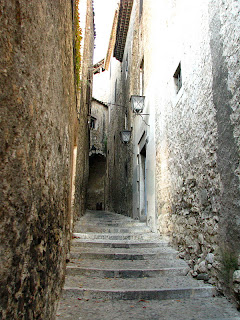
On her first weekend, we took a trip to the small medieval town of Girona, an easy train trip from Barcelona. Girona is an ancient, walled city, and has been fought over in almost every century since it was founded as a Roman fortress. As many as 21 beisieges have been counted, earning it the name "Immortal" during its 19th attack. When the Moors came to Spain, Girona was an Islamic town for over 200 years. You can really see this in the labrynth of narrow alleys and pathways. There was also a continuous Jewish presence in the city for six hundred years. As a result of all the different people that have conquered it, the city is a hodgepodge of architectural styles.
We stayed in Hotel Bellmiral, a refurbished 15th century building, in the middle of the medieval quarter. The whole time we walked around Barri Vell, the old part of town, I felt like we were living in the medieval times. If Hollywood were to film a medieval movie in Girona, they wouldn't have to change a thing. It's completely preserved.

This is the Cathedral of Girona, an excellent example of the Catalan Gothic architectural style, and right by our hotel. The foundation has been a place of worship since the Roman times, and before the Christians built the Cathedral, the Moors had built a mosque here. The Cathedral was started in 1038, but most of the structure dates from the 15th century.
This is the main facade, remodelled in the 18th century, and covered in flowers, coats of arms, and statues.
The cloister attached to the church (which is one of my 9th graders' vocabulary words as we study A Midsummer Night's Dream, and one of Miss Simpson's new words, too!) is from the 12th century, and features minutely carved figures and scenes on columns.
Next, we headed toward the Arab Baths, by walking through the Passeig de la Muralla, and through landscaped gardens.

Here it is! (I foreshadowed this shot in my last blog.)
The Banys Arabs, or Arab Baths, were gorgeous! A little bit o' hamam in Spain! These baths were designed by Moorish architects around 1194 and rebuilt a century later. It was closed down in the 15th century to protect public morals, and was appropriated as a Christian convent in 1617. Then they were restored by local architects and reopened to the public as a museum in 1929. This is the changing room.

Little holes just like in Turkish hamams...same shapes!
This is the steam room.
And the view from the roof...
Then we took a walk to find the old city walls, where supposedly you could still walk atop them, and cover the whole perimeter of the old city.
It took a little while to find an entrance.
Here it is!
The city is built along the River Onyar. There are several bridges crossing the river to the cafe-lined Rambla. You can see now the architecture is more modern; there are even the occasional modernisme-style buildings.
On Saturday night, we wandered through El Call, the preserved Jewish quarter of the city. We walked along Carrer de la Forca (Forca Street). El Call had a population of over 300 Jews at its peak. But from the 13th century onward, the Jews of Girona suffered systematic persecution. By1391, it was a restrictive ghetto, and in 1492 the Jews were completely expelled from Spain.
The Cathedral at sunset.
Even if we could stave our hunger until 8pm, it was still too early for the Spanish to eat, and as usual, we began our supper with the whole restaurant to ourselves!
The next morning, the sun came out, so we were able to wander the tight passageways and take some photos of the light.
Mmmm, Christmas cupcakes... But all shops are closed on Sundays....
From Girona on Sunday morning, we took the train another 20 minutes north to Figueres so my mom could see the crazy Dali museum. It was quite the switch, from medieval to surreal!












































No comments:
Post a Comment